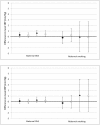Associations of social and economic and pregnancy exposures with blood pressure in UK White British and Pakistani children age 4/5
- PMID: 29895845
- PMCID: PMC5997744
- DOI: 10.1038/s41598-018-27316-1
Associations of social and economic and pregnancy exposures with blood pressure in UK White British and Pakistani children age 4/5
Erratum in
-
Author Correction: Associations of social and economic and pregnancy exposures with blood pressure in UK White British and Pakistani children age 4/5.Sci Rep. 2018 Sep 26;8(1):14591. doi: 10.1038/s41598-018-32318-0. Sci Rep. 2018. PMID: 30258196 Free PMC article.
Abstract
South Asians have higher rates of coronary heart disease (CHD) than White European individuals. Blood pressure (BP) is one of the most important risk factors for CHD and ethnic differences in BP have been identified in childhood. Early life exposures could explain some of these differences. We examined associations of family social and economic and maternal pregnancy exposures and BP at age 4/5 in 1644 White British and 1824 Pakistani mother-offspring pairs from the Born in Bradford study. We found that systolic BP was similar but diastolic BP was higher, in Pakistani compared to White British children (adjusted mean differences were -0.170 mmHg 95% CI -0.884, 0.543 for systolic BP; 1.328 mmHg 95% CI 0.592, 2.064 for diastolic BP). Social and economic exposures were not associated with BP in either ethnic group. Maternal BMI was positively associated with BP in both groups but this association was mediated by child BMI. Only gestational hypertension was associated with child systolic and diastolic BP and this was only identified in Pakistani mother-offspring pairs. These findings suggest that Pakistani populations may have a different BP trajectory compared to White British groups and that this is already evident at age 4/5 years.
Conflict of interest statement
DAL has received support from Roche Diagnostics and Medronic for biomarker research unrelated to the research presented here. All other authors of this manuscript declare no conflicts of interest.
Figures





Similar articles
-
Association of maternal exposures with adiposity at age 4/5 years in white British and Pakistani children: findings from the Born in Bradford study.Diabetologia. 2018 Jan;61(1):242-252. doi: 10.1007/s00125-017-4457-2. Epub 2017 Oct 24. Diabetologia. 2018. PMID: 29064033 Free PMC article.
-
Blood pressure change across pregnancy in white British and Pakistani women: analysis of data from the Born in Bradford cohort.Sci Rep. 2019 Sep 13;9(1):13199. doi: 10.1038/s41598-019-49722-9. Sci Rep. 2019. PMID: 31520065 Free PMC article.
-
Ethnic and socioeconomic influences on childhood blood pressure: the Child Heart and Health Study in England.J Hypertens. 2012 Nov;30(11):2090-7. doi: 10.1097/HJH.0b013e32835837c9. J Hypertens. 2012. PMID: 22990353 Free PMC article.
-
Differences in socioeconomic position, lifestyle and health-related pregnancy characteristics between Pakistani and White British women in the Born in Bradford prospective cohort study: the influence of the woman's, her partner's and their parents' place of birth.BMJ Open. 2014 Jun 19;4(6):e004805. doi: 10.1136/bmjopen-2014-004805. BMJ Open. 2014. PMID: 24948746 Free PMC article.
-
Heterogeneity in blood pressure in UK Bangladeshi, Indian and Pakistani, compared to White, populations: divergence of adults and children.J Hum Hypertens. 2018 Nov;32(11):725-744. doi: 10.1038/s41371-018-0095-5. Epub 2018 Sep 4. J Hum Hypertens. 2018. PMID: 30181657 Review.
Cited by
-
Associations of maternal gestational hypertension with high blood pressure and overweight/obesity in their adolescent offspring: a retrospective cohort study.Sci Rep. 2022 Mar 8;12(1):3800. doi: 10.1038/s41598-022-07903-z. Sci Rep. 2022. PMID: 35260718 Free PMC article.
-
Expression and role of miR-338-3p in peripheral blood and placenta of patients with pregnancy-induced hypertension.Exp Ther Med. 2020 Jul;20(1):418-426. doi: 10.3892/etm.2020.8719. Epub 2020 May 6. Exp Ther Med. 2020. PMID: 32537006 Free PMC article.
-
Ethnic differences in kidney function in childhood: the Born in Bradford Cohort Renal Study.Wellcome Open Res. 2023 Aug 25;7:112. doi: 10.12688/wellcomeopenres.17796.2. eCollection 2022. Wellcome Open Res. 2023. PMID: 37274450 Free PMC article.
-
Associations of cord leptin and cord insulin with adiposity and blood pressure in White British and Pakistani children aged 4/5 years.Wellcome Open Res. 2019 Oct 15;4:157. doi: 10.12688/wellcomeopenres.15433.1. eCollection 2019. Wellcome Open Res. 2019. PMID: 32954010 Free PMC article.
-
Growing up in Bradford: protocol for the age 7-11 follow up of the Born in Bradford birth cohort.BMC Public Health. 2019 Jul 12;19(1):939. doi: 10.1186/s12889-019-7222-2. BMC Public Health. 2019. PMID: 31300003 Free PMC article.
References
Publication types
MeSH terms
Grants and funding
LinkOut - more resources
Full Text Sources
Other Literature Sources
Medical

